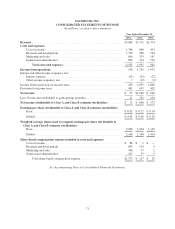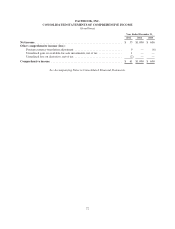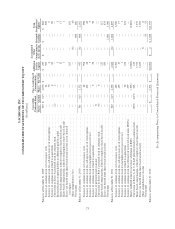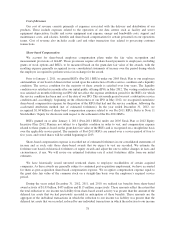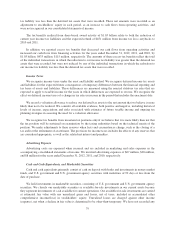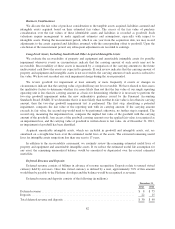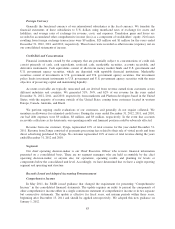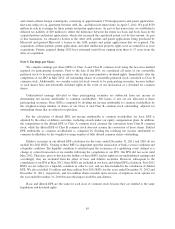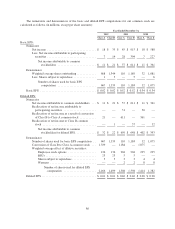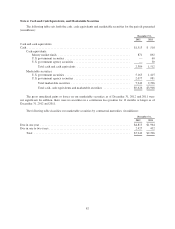Facebook 2012 Annual Report Download - page 82
Download and view the complete annual report
Please find page 82 of the 2012 Facebook annual report below. You can navigate through the pages in the report by either clicking on the pages listed below, or by using the keyword search tool below to find specific information within the annual report.Cost of Revenue
Our cost of revenue consists primarily of expenses associated with the delivery and distribution of our
products. These include expenses related to the operation of our data centers such as facility and server
equipment depreciation, facility and server equipment rent expense, energy and bandwidth costs, support and
maintenance costs, and salaries, benefits and share-based compensation for certain personnel on our operations
teams. Cost of revenue also includes credit card and other transaction fees related to processing customer
transactions.
Share-based Compensation
We account for share-based employee compensation plans under the fair value recognition and
measurement provisions of GAAP. Those provisions require all share-based payments to employees, including
grants of stock options and RSUs, to be measured based on the grant-date fair value of the awards, with the
resulting expense generally recognized in our consolidated statements of income over the period during which
the employee is required to perform service in exchange for the award.
Prior to January 1, 2011, we granted RSUs (Pre-2011 RSUs) under our 2005 Stock Plan to our employees
and members of our board of directors that vested upon the satisfaction of both a service condition and a liquidity
condition. The service condition for the majority of these awards is satisfied over four years. The liquidity
condition was satisfied six months after our initial public offering (IPO) in May 2012. The vesting condition that
was satisfied six months following our IPO did not affect the expense attribution period for the RSUs for which
the service condition has been met as of the date of our IPO. This six-month period was not a substantive service
condition and, accordingly, beginning on the effectiveness of our IPO in May 2012, we recognized cumulative
share-based compensation expense for the portion of the RSUs that had met the service condition, following the
accelerated attribution method (net of estimated forfeitures). In the year ended December 31, 2012, we
recognized $1.04 billion of share-based compensation expense related to our Pre-2011 RSUs. Refer to Note 11
Stockholders’ Equity for disclosure with respect to the settlement of the Pre-2011 RSUs.
RSUs granted on or after January 1, 2011 (Post-2011 RSUs) under our 2005 Stock Plan or 2012 Equity
Incentive Plan (2012 Plan)are not subject to a liquidity condition in order to vest, and compensation expense
related to these grants is based on the grant date fair value of the RSUs and is recognized on a straight-line basis
over the applicable service period. The majority of Post-2011 RSUs are earned over a service period of four to
five years, and vested shares will be settled beginning in 2013.
Share-based compensation expense is recorded net of estimated forfeitures in our consolidated statements of
income and as such, only those share-based awards that we expect to vest are recorded. We estimate the
forfeiture rate based on historical forfeitures of equity awards and adjust the rate to reflect changes in facts and
circumstances, if any. We will revise our estimated forfeiture rate if actual forfeitures differ from our initial
estimates.
We have historically issued unvested restricted shares to employee stockholders of certain acquired
companies. As these awards are generally subject to continued post-acquisition employment, we have accounted
for them as post-acquisition share-based compensation expense. We recognize compensation expense equal to
the grant date fair value of the common stock on a straight-line basis over the employee’s required service
period.
During the years ended December 31, 2012, 2011, and 2010, we realized tax benefits from share-based
award activity of $1.03 billion, $433 million and $115 million, respectively. These amounts reflect the extent that
the total reduction to our income tax liability from share-based award activity was greater than the amount of the
deferred tax assets that we had previously recorded in anticipation of these benefits. These amounts are the
aggregate of the individual transactions in which the reduction to our income tax liability was greater than the
deferred tax assets that we recorded, reduced by any individual transactions in which the reduction to our income
78





